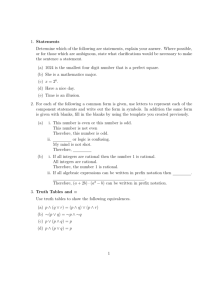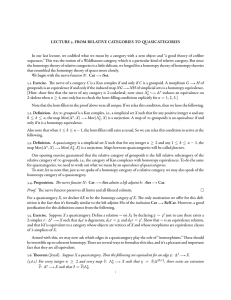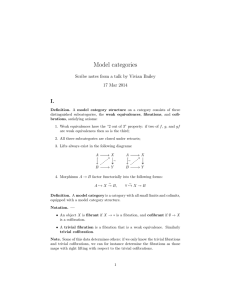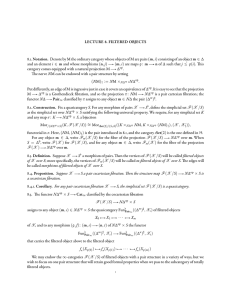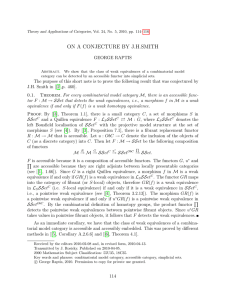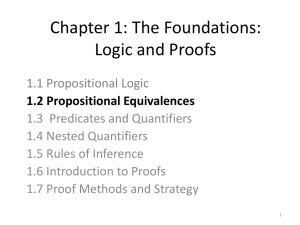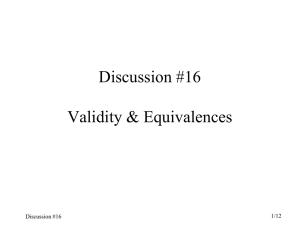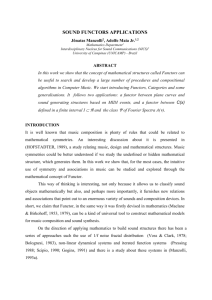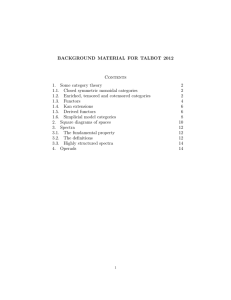LECTURE . WALDHAUSEN CATEGORIES, AND A DELOOPING OF THE UNIVERSAL K
advertisement
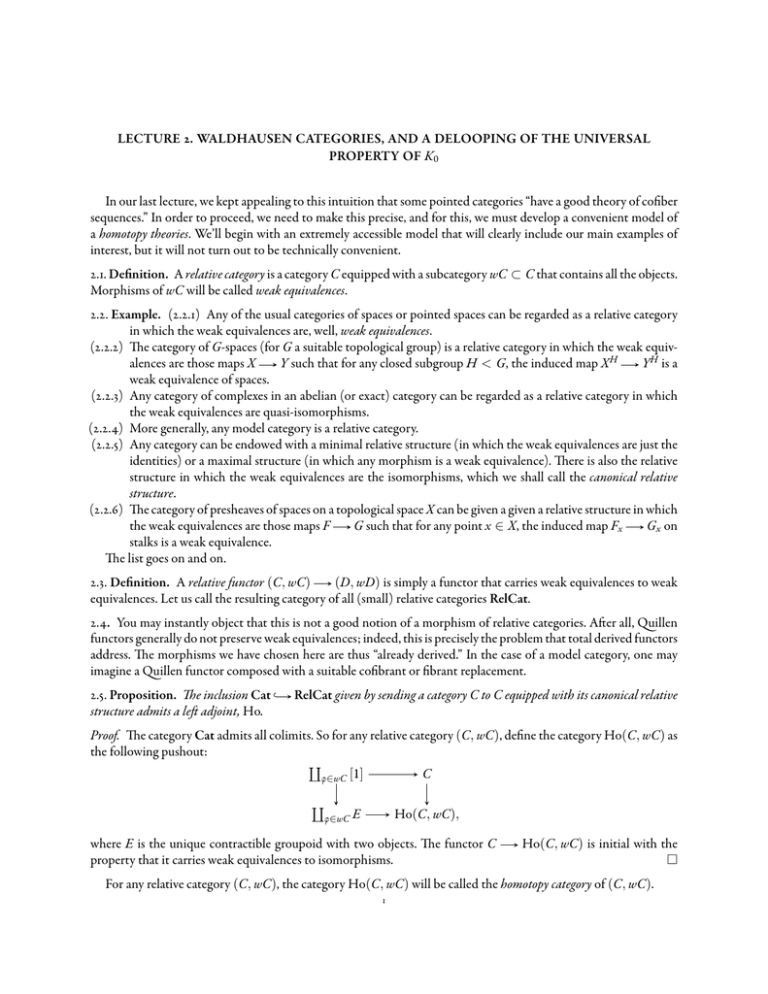
LECTURE . WALDHAUSEN CATEGORIES, AND A DELOOPING OF THE UNIVERSAL
PROPERTY OF K0
In our last lecture, we kept appealing to this intuition that some pointed categories “have a good theory of cofiber
sequences.” In order to proceed, we need to make this precise, and for this, we must develop a convenient model of
a homotopy theories. We’ll begin with an extremely accessible model that will clearly include our main examples of
interest, but it will not turn out to be technically convenient.
.. Definition. A relative category is a category C equipped with a subcategory wC ⊂ C that contains all the objects.
Morphisms of wC will be called weak equivalences.
.. Example. (..) Any of the usual categories of spaces or pointed spaces can be regarded as a relative category
in which the weak equivalences are, well, weak equivalences.
(..) e category of G-spaces (for G a suitable topological group) is a relative category in which the weak equivalences are those maps X . Y such that for any closed subgroup H < G, the induced map XH . YH is a
weak equivalence of spaces.
(..) Any category of complexes in an abelian (or exact) category can be regarded as a relative category in which
the weak equivalences are quasi-isomorphisms.
(..) More generally, any model category is a relative category.
(..) Any category can be endowed with a minimal relative structure (in which the weak equivalences are just the
identities) or a maximal structure (in which any morphism is a weak equivalence). ere is also the relative
structure in which the weak equivalences are the isomorphisms, which we shall call the canonical relative
structure.
(..) e category of presheaves of spaces on a topological space X can be given a given a relative structure in which
the weak equivalences are those maps F . G such that for any point x ∈ X, the induced map Fx . Gx on
stalks is a weak equivalence.
e list goes on and on.
.. Definition. A relative functor (C, wC) . (D, wD) is simply a functor that carries weak equivalences to weak
equivalences. Let us call the resulting category of all (small) relative categories RelCat.
.. You may instantly object that this is not a good notion of a morphism of relative categories. Aer all, uillen
functors generally do not preserve weak equivalences; indeed, this is precisely the problem that total derived functors
address. e morphisms we have chosen here are thus “already derived.” In the case of a model category, one may
imagine a uillen functor composed with a suitable cofibrant or fibrant replacement.
.. Proposition. e inclusion Cat .
structure admits a le adjoint, Ho.
RelCat given by sending a category C to C equipped with its canonical relative
Proof. e category Cat admits all colimits. So for any relative category (C, wC), define the category Ho(C, wC) as
the following pushout:
⨿
. [1]
C.
φ∈wC
.
⨿
. E
Ho(C,. wC),
φ∈wC
where E is the unique contractible groupoid with two objects. e functor C .
property that it carries weak equivalences to isomorphisms.
Ho(C, wC) is initial with the
□
For any relative category (C, wC), the category Ho(C, wC) will be called the homotopy category of (C, wC).
.. Exercise. Show that if (C, wC) is a relative category such that the underlying category C contains a terminal
object Z, then Z is also a terminal object of Ho(C, wC).
We will be dealing primarily with relative categories that contain a zero object, 0. We’d also like to make sense of
the idea that for certain morphisms X . Y, a square
X.
Y.
.
0.
Z.
is a homotopy pushout. Given this notion, the existence of a subcategory of morphisms X . Y for which such
homotopy pushouts exist is precisely what we will mean by the assertion that (C, wC) admits a good theory of cofibers.
It is possible to develop the general theory of homotopy pushouts entirely in the context of relative categories,
but this has some technical disadvantages. Waldhausen avoids this by selecting particular models for the homotopy
pushouts.
.. Definition. A Waldhausen category is a pointed relative category (C, wC) equipped with a subcategory C† ⊂ C
containing every object — whose objects are called cofibrations and are denoted X . Y — such that the following
axioms are satisfied.
(..) For any object X of C, the unique morphism 0 . X is a cofibration.
(..) For any cofibration U . V and any morphism U . X, there exists a pushout square
U.
V.
.
X.
Y..
U.
V.
(..) For any pushout square
.
X.
if U . V is a cofibration, then so is X .
(..) Finally, suppose
Y,.
Y.
.
U.
X.
.
.
U. ′
X. ′
.
.
.
V.
Y.
.
.
V. ′
Y.′
.
a commutative cube in which the top and bottom faces are pushouts; the indicated morphisms are cofibrations; and the morphisms U . U ′ , V . V ′ , and X . X ′ are weak equivalences. en Y . Y ′ is a weak
equivalence as well.
Let C2 be the full subcategory of Fun([1] × [1], C) spanned by squares of the form
U.
V.
.
X.
Y,.
and let C⌜ be the full subcategory of Fun([1] ∪{0} [1], C) spanned by diagrams of the form
U.
V.
.
X..
.
Both C2 and C⌜ can be given relative category structures, in which the weak equivalences are defined objectwise.
e latter three axioms can now be summarized by saying that the forgetful functor C2 . C⌜ admits a le adjoint
that is also a relative functor.
.. Example. e relative category of pointed finite CW complexes is a Waldhausen category in which the cofibrations are cellular inclusions.
For any abelian category A , the relative category of bounded chain complexes in A is a Waldhausen category in
which a cofibration is a map E . F such that for any n ∈ Z, the morphism En . Fn is a monomorphism. is
can be extended also to suitable full additive subcategories B ⊂ A : a cofibration is a map E . F such that for any
n ∈ Z, the morphism En . Fn is a monomorphism whose cokernel lies in B as well.
Now a cofiber sequence E′ .
E.
E′′ of a Waldhausen category C is simply a pushout square
E.′
E.
.
E.′′
0.
therein, and we can speak of Euler characteristics Obj Ho C . A just as we did in the first lecture. All the results
there apply, but we can go further. Let’s understand the role played in K-theory by filtered objects.
.. Definition. A filtered object X of length m in a Waldhausen category C is a sequence
X0 .
··· .
X1 .
Xm
of cofibrations. We shall say that X is totally filtered if X0 is a zero object.
Denote by Fm (C) the category of filtered objects of C, and denote by Sm (C) the category of totally filtered objects
of C. One may show that with weak equivalences defined objectwise, there is a suitable notion of cofibration with
respect to which these categories are Waldhausen categories. [Inna Zakharevich points out that objectwise cofibrations aren’t going to work. Aer all, thanks to (..), weak equivalences glue, but cofibrations don’t. To repair this,
we’ll take a slightly smaller class for Fm (C)† ; in fact, we will take the smallest class for which the needed pushouts all
exist. We’ll revisit this point later.] Note that there is an obvious forgetful functor S1+m (C) . Fm (C) (which even
makes sense when m = −1).
Let us write Jm for the obvious fully faithful inclusion Sm (C) . Fm (C). ere is also a fully faithful functor
Em : C . Fm (C), which carries any object X of C to the trivial filtration on X. Now any Euler characteristics
χ : Obj Ho Fm (C) . A must split as a sum χ ◦ Jm and χ ◦ Em ; to see this, one need only consider the cofiber
sequence
X.0
X.0
· ·.·
X.0
X.0
X.1
. · ·. ·
X.m
0.
X1/0
.
· ·. ·
Xm/0
. .
in Fm (C).
In the other direction, the inclusion Jm : Sm (C) . Fm (C) admits a le adjoint Fm : Fm (C) .
a filtered object
X0 . X1 . · · · . Xm
Sm (C) that carries
to the totally filtered object
0.
··· .
X1/0 .
Xm/0 ,
and the functor Em : C . Fm (C) admits a right adjoint Im : Fm (C) .
X0 .
For now, we have a diagram of Waldhausen categories
0.
Sm (C)
.
0.
C.
Fm (C)
..
C.
0.
Sm (C)
.
0,.
C that carries a totally filtered object X to
commutative up to natural isomorphism, in which the long maps are all identities (again up to natural isomorphism).
is gives us a diagram of functors
X(0,. −)
X(Sm (C),
. −)
X(0,. −)
X(C,. −)
X(Fm (C),
.. −)
X(C,. −)
X(0,. −)
X(Sm (C),
. −)
X(0,. −).
Putting this together, we have the following.
.. Proposition. For any Waldhausen category C, the above diagram provides a splitting
K0 (Fm (C)) ∼
= K0 (C) ⊕ K0 (Sm (C)).
But there’s more to the story. When m varies, we get induced functors on these categories. Indeed, if φ : [m] . [n]
is a morphism of the category Δ, then we get an induced functor φ⋆ : Fn (C) . Fm (C). Note, however, that unless
φ(0) = 0, the functor φ∗ does not carry totally filtered objects to totally filtered objects. But, we can repair this by
composing φ∗ with Fm . en we obtain a functor φ⋆ : Sn (C) . Sm (C) such that the square
Fn (C)
.
Sn (C)
.
.
Fm (C)
.
Sn (C)
.
commutes (up to natural isomorphism). is makes S∗ (C) into a simplicial object. Hence X(S∗ (C), −) can be regarded as a simplicial object of functors Fun(Ab, Set).
.. eorem. e simplicial object X(S∗ (C), −) satisfies the Segal condition.
Put differently, the abelian group structure on K0 (C ) came for free from the simplicial object S∗ (C). Expressed
still differently, the universal property of K0 can be “delooped” in the following manner. For any abelian group A,
the simplicial maps Obj Ho S∗ (C) . B∗ (A) are in one-to-one correspondence with the pointed simiplicial maps
B∗ K0 (C) . B∗ (A).
But we see that such an Euler characteristic is a quite coarse invariant of a Waldhausen category C, as it simply
identifies two objects between which there exists an equivalence. In homotopy theory, we prefer to keep track of all
the ways in which two objects might be equivalent. So instead of looking at simplicial maps out of Obj Ho S∗ (C),
we might try looking at simplicial maps out of the simplicial space NwS∗ (C), and we needn’t have them valued in the
classifying space of an abelian group A, but in the classifying space of a loopspace, i.e., in a simplicial space satisfying
the Segal condition.
We are led to the following statement, which is originally due to Waldhausen.
.. Proposition. e space of simplicial maps NwS∗ (C) . B∗ ΩX is homotopy equivalent to a space of loop maps
K(C) . ΩX, whose source is called the K-theory space of C.
ere are awkwardnesses of this picture. First, many of the diagrams that have appeared here are not quite commutative; they are only commutative up to natural isomorphisms. Solving these coherence problems isn’t a tremendous
inconvenience, but it must be done. More importantly, one can trace through the effect of a natural weak equivalence between two functors of Waldhausen categories on K-theory, but the effect of a homotopy between such
equivalences is hard to pinpoint.
To give a concrete example, let us consider the Waldhausen categories CWB/ /B . Because the action of the space
hAut(B) on CWB/ /B is difficult to model, one has almost no access to the action of hAut(B) on the K-theory
K(CWB/ /B ). For this reason, we aim to wove to a context where the homotopy theory of homotopy theories is readily
accessible.
